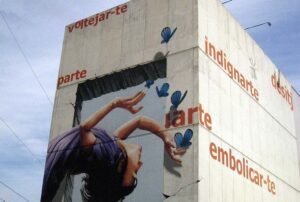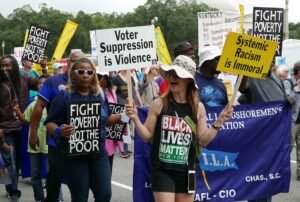
Those of us who cut our teeth in the community development movement, working for community action agencies in the War on Poverty or working for community development corporations—including those that were created or boosted through the Special Impact Program of the Economic Opportunity Act of 1964 and Title VII of the Community Services Act of 1974—know a fundamental truth about nonprofit community development corporations. For all of the arm’s length advocacy on behalf of poor people done by professional policy advocates who never seem to come within yards of the people they purport to represent, Community Development Corporations and the CDC movement in general have been assiduous advocates with and on behalf of poor people in inner cities and in rural communities.
The work of the best CDCs is reflective of the theory of “non-reformist reform.” CDCs get things done, but in the course of doing so, they achieve more than outputs of housing and services. They create a different dynamic of community development in poor neighborhoods. In this dynamic residents see that they can get things done for themselves at the same time as they more generally advocate for vital resources and supports from local, state, and federal governmental authorities for all communities.
Not all CDCs are there on the simultaneous achievement of concrete improvements in poor people’s lives and advocacy for systemic changes in public policy toward the inner city and rural poor. But some truly epitomize the best of the field by pushing for social change while implementing creative on-the-ground programming. This is what makes community development a distinctive segment of the nonprofit sector, functioning,at the intersection of advocacy and progress.
Beyond Bricks and Mortar
Almost everyone knows that homeownership is a good way to build assets and wealth, but during the bank-created economic recession, hundreds of thousands of Americans were—and still are—facing mortgage foreclosures. Saving homes from foreclosure can be thought of as a real estate transaction, but for CDCs it is an intervention to help people avoid losing their major and sometimes only asset, and simultaneously to help whole communities resist decline.
Flint, Michigan is one of the iconic communities devastated by the nationwide foreclosure crisis. However, homeowners like Regina Richards, who had been laid off from one of her two jobs, might have lost their homes due to a build-up of unpaid property taxes and other expenses had it not been for the ability of an organization called Metro Community Development. The group provided her with financial counseling and eventually helped her get access to a program that provided zero interest loans to struggling homeowners. Metro Community Development[1] gets it that the issue isn’t simply housing units, it’s people. “Families lose assets, and those who don’t, lose value in their assets,” Metro Community Development CEO Ravi Yalamanchi said. “It’s a huge challenge.”
CDCs and their intermediary partners do themselves a great injustice when they boil down their activities and accomplishments to the production of housing units or, perhaps even more narrowly, how much money they have borrowed from banks and other lenders to make affordable housing happen. Housing production is an old-fashioned, myopic, and frequently inaccurate lens on what nonprofit community development corporations do
For example, in York, Pennsylvania, the Y Community Development Corporation[2] is opening a market for the sale of fresh fruits and vegetables. Only one other supermarket within the city limits of York sells fresh fruits and vegetables. The YCDC’s new Green Food Market will change that equation and provide educational outreach along with the fresh produce, due to a $225,000 “Racial and Ethnic Approaches to Community Health” (REACH) grant from the Centers for Disease Control.
The creativity of community development corporations frequently extends into the arts, in recognition of the importance of multiple dimensions of what might constitute a healthy community. For example, in rural Wayne County, West Virginia, the Coalfield Development Corporation, which typically recruits and trains low-income high school graduates to redevelop properties as affordable housing while they learn the skills of the construction trades, is now venturing into the arts. It has acquired an unused industrial facility to renovate as apartments and work space for artists. A significant step toward that project was Coalfield’s[3] receipt of a $350,000 grant from ArtPlace America, a financial intermediary helping communities acquire and build creative spaces. And it received its development financing from Community Works, a West Virginia-based CDFI.
Coalfield’s venture into the arts isn’t simply a development project, but a contribution to an improved, holistic quality of life in the region. In Flint, Communities First launched its “Culture Shock” program by bringing musicians from the Flint Symphony to the downtown bus terminal to play classical violin, cello, and viola pieces. That followed previous Culture Shock programs including players from multiple orchestras during the “Artwalk” in June, a performance by a Mott Community College-based percussion group called Exclamation, and a tour of families from public housing projects to arts programs at the Flint Institute of Arts.
The Flint Symphony players took questions about classical music from people at the MTA Terminal and seemed more than pleased with the event. “Particularly nowadays, the classical world is looking for ways to broaden our audiences,” said Daniel Winnick, a member of the Symphony and a teacher for a nonprofit that encourages minority participation in classical music. “We believe our music can be enjoyed by anyone, it’s just a matter of getting it exposed to more people.” It is quite a departure in the public’s consciousness, but perhaps not for the sponsoring organization itself, to have Communities First,[4] largely devoted to housing and economic development, working on the connecting the arts more broadly to the population of Flint.
The Flint and Coalfield programs reflect a CDC commitment to making communities more livable for people who would otherwise be displaced, removed, or forgotten by the powers that be. In Pittsburgh, the Hill Community Development Corporation[5] (sometimes called “Hill District CDC” in press reports) is working with Carnegie Mellon University architecture students in the Remaking Cities Institute, supported by the Heinz Endowments, to re-envision a future for Centre Avenue commercial corridor. “It’s been interesting for us as designers to consider buildings as vessels for social interaction,” CMU architecture instructor Steve Quick said. “Architecture in support of social structure.” “This project is intended to show developers what we want and who we want to be,” Marimba Milliones, the Hill CDC executive director, explained. “If they match us, that’s the developer we want.”
Consistent with a citizen-generated development plan from 2011, the Hill CDC has joined with the Hill District Consensus Group to establish a joint development review panel to guide “inclusive community-level review of development efforts for the neighborhood.” The press coverage seemed to focus on the dynamic between the participating organizations in negotiating the respective roles of their organizations, but the deeper importance of both the joint development review panel and the commercial corridor design effort is that they reflect the CDC’s commitment to a community-led, resident-led planning and development process.
CDCs and Political Ties
Because they sometimes are involved in big dollar transactions and activities that necessarily overlap with or must be coordinated with the public sector, CDCs often run the risk of being too closely identified with local politicians and this can lead to suspicions of conflicts of interest or self dealing – sometimes justified and sometimes not.
In East Biloxi, Mississippi, a CDC that had rebuilt houses for people whose homes were damaged or lost in Hurricane Katrina has come under state scrutiny for, among other things, flipping houses for “profit.”
Bill Stallworth, the East Biloxi CDC executive director, explains that the group has done nothing outside of its mission and in fact is trying to advance it.”We try and find homes that are able to be re-habbed, turned, and sold and then those proceeds are coming back into the agency. We don’t get to keep any of the money. We’re just trying to find opportunities that we can continue our mission,” Stallworth is not without a political identity as a former city councilman from East Biloxi who created the organization in the wake of the crisis of Hurricane Katrina. The organization was credible enough to be work with both the NAACP and Oxfam to get resources to displaced residents of East Biloxi. .
But the government audit from the Mississippi Secretary of State, looking for any misuse of government or charitable money, was apparently conducted without talking to the executive director or staff of the nonprofit, Hope Community Development Agency,[6] and as a result it may be somewhat skewed, assuming for instance that the executive director, Bill Stallworth, was related to a beneficiary of the agency because they had the same surname. . That assumption, according to Stallworth, led investigators to suspect that the organization was involved in a scheme to benefit family relatives of the staff or director. That and other findings suggest that the authors of the state government review may not have understood CDCs, many not have bothered to try to understand them, and might have had another, political agenda in mind rather than simply HCDA’s financial probity.
In Philadelphia, the once highly respected Ogontz Avenue Revitalization Corporation[7] has been in turmoil for some time, partly due to its ties with a Pennsylvania State Representative, Dwight Evans. It also involved itself in more than one project that raised eyebrows, such as the purchase of a financially troubled nightclub owned by friends of Evans and the expenditure of $1 million on a neighborhood jazz festival. During the past four years, OARC has been struggling with the state, fending off critical inspector general reports that the CDC misspent state funds. It eventually returned $1.2 million in contested state grant funds and the board has dismissed the nonprofit’s longtime executive director, appointing the chair of the Lincoln University board of trustees in his place.
Some politicians find CDCs to be attractive vehicles for their non-legislative activities, which may be a positive thing in the case of East Biloxi’s Bill Stallworth but potentially disastrous for the West Oak Lane neighborhoods covered by the legislative district of Dwight Evans. So often, when a CDC gets into trouble, it is because it is taking its cues not from the community, but from a politician.
The CDC Story of Today
Community development corporations, when they are working well, are doing much more than affordable housing. They are building and rebuilding communities in all their dimensions—arts, culture, jobs, and design. When they are working particularly well, they are working from the energies and direction of community residents, empowering them to take control of their communities from politicians and developers who might not have their interests in mind, if they are even aware of them at all.
For those of us from the movement who look back at our time working with community development corporations, we know the kind of creative ferment that reflects the best of the nonprofit CDCs. We also know the instances of political manipulation by politicians who envision on occasion that CDCs can be converted into their political clubs to service their friends and allies—like bailing out friendly nightclub owners. The good CDCs are generally in the forefront of community change, job development, and anti-poverty programming, not imagining what people need, but talking with them, listening to them, and feeding off their energies to be creative in their program activities on the ground and in their local and national public policy advocacy.
Sign up for our free newsletters
Subscribe to NPQ's newsletters to have our top stories delivered directly to your inbox.
By signing up, you agree to our privacy policy and terms of use, and to receive messages from NPQ and our partners.
It’s not ideology, just pragmatism, to suggest that the power of the community development movement is its ability to work at the community level on concrete, visible, tangible projects and programs, and to use those programs to infuse authentic substance into their public policy advocacy. Groups like those in Flint, in Westmoreland, West Virginia, and in the Hill district of Pittsburgh are exemplars of nonprofits engaged in community-level democracy. Long ago, back in the days of the War on Poverty, community development in terms of housing and jobs was always a part of community political development. Maybe with the Hill District, Flint, and other examples, the community development sector is headed back to the future. That would be a very good thing.
NOTES
- In 1992, the concerted housing revitalization efforts of community leaders, nonprofit representatives, government leaders, local lenders and businesses, and with assistance from C.S. Mott Foundation led to the creation of Metro Housing Partnership. Metro was to serve as the housing and community development intermediary in Flint and Genesee County with a focus on providing technical and financial resources, creating public and private partnerships, leading to the creation of stable neighborhoods and communities…PURPOSE…To identify and select target areas within the greater Flint Metropolitan area on which to focus the comprehensive revitalization efforts of the Corporation in order to improve physical and socio-economic conditions therein and thereby reduce the burden on the federal, state and local government to provide social and welfare programs to the residents of such areas. To demonstrate the ways in which targeted public/private resources can provide a return on investment to sponsors and financiers through improvement of the overall socio-economic climate of the community. To increase private sector support for affordable housing and neighborhood revitalization through establishment and maintenance of affordable housing financing programs. To build the production capacity of nonprofit housing developers in the greater Flint Metropolitan area through the provision of training, professional and technical assistance and by increasing the availability of financial resources.
To combat community blight and deterioration in greater Flint Metropolitan area by helping to maintain, improve and increase the supply of affordable housing to lower income residents of the area through educational activities and such financing programs.” - “The Y Community Development Corporation was formed in 1998 and for 15 years has been providing safe, clean and affordable housing for York County’s workforce. YCDC owns In 2012, a strategic partnership was formed with the Housing Alliance of York, creating Y Housing Resources. The mission of YHR is to couple affordable housing with the provision of housing counseling services to create stable and long-term living for York County residents” –
- “The Coalfield Development Corporation’s mission is to be a community based organization that provides quality and affordable homes, creates quality jobs, and generates opportunities for quality lives for low-income families in coalfields of West Virginia. Improvement in these areas will be the gears generating real change in Appalachia. In 2008, the Coalfield Development Corporation was founded as a Community Housing Development Corporation (CHDO) by local citizens concerned by the lack of quality affordable housing. The organization was slow getting started, struggling against long-entrenched barriers. However, Brandon Dennison, the founding executive director, saw the potential in this organization for creating an active, grassroots movement capable of achieving larger-scale change”
- Communities First’s statement of “WHAT WE DO”: “AFFORDABLE HOUSING
Pursuing funding to support affordable housing development
Developing housing for low to moderate income individuals
Developing housing for vulnerable populations
Establishing partnerships to develop affordable housing
ECONOMIC DEVELOPMENT
Creating employment opportunities
Providing business development services to youth and adult entrepreneurs
Securing funding for distressed communities
Developing mixed-use commercial projects
GREEN PROGRAMS
Educating residents and businesses about developing environmentally friendly habits
Utilizing sustainable operating practices
Employing green construction methods
Promoting and producing environmentally sustainable communities
QUALITY OF LIFE PROGRAMS
Improve the overall quality of life for residents of distressed communities
Educating residents and businesses about developing environmentally friendly habits through the Green Life Community Education Program
Provide opportunities for cultural exposure to affordable housing and community residents through Culture Shock, an innovative program designed to inspire an interest in arts and culture”
-
“Serving the Greater Hill District of Pittsburgh, PA, the Hill CDC works with private, public non-profit developers, and other interested parties in early stages of planning, design and implementation of community development projects to assure alignment with appropriate stakeholders and the community master plan.”
-
After its initial hurricane relief activities, “Hope eventually evolved into a full-service resource center for residents—a place where residents come to share their aspirations and concerns regarding the rebuilding effort, to participate in planning for both the immediate recovery and long-term prosperity of their community, and create a shared vision for the future of their community. In this vein, Hope engaged in a large-scale community survey, published as the East Biloxi Community Plan–a participatory planning process of East Biloxi residents balancing redevelopment hopes with the concerns and priorities of the communities that were there before the hurricanes. Hope has become the ‘hub’ around which East Biloxi’s recovery, rebuilding and redevelopment activity has been centered.”
-
“OARC has been responsible for the development of dozens of housing units, several of the marquee business institutions of West Oak Lane, the creation of hundreds of jobs in the community and the overall improvement in the quality of life in one of Philadelphia’s finest neighborhoods… Since its inception, OARC has grown to include ten entities with a total annual operating budget of approximately $25 million and development projects valued at over $24 million. OARC, its related entities and affiliates employ more than 250 people full-time, more than 30 people part-time and serve approximately 1,000 children annually”













